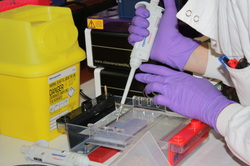GNAQ/GNA11 mutational analysis

Indication
Mutually exclusive mutations affecting exon 4, codon 183 or exon 5, codon 209, of the G protein α-subunit Q (GNAQ) gene and the G protein α-subunit 11 (GNA11) gene are found in approx 84% of uveal melanomas. The identification of the mutational profile of exons 4 and 5 of GNAQ/GNA11 will facilitate improvement in our knowledge of these neoplasms, and may be useful for selection of patients for targeted therapeutic approaches.
Mutually exclusive mutations affecting exon 4, codon 183 or exon 5, codon 209, of the G protein α-subunit Q (GNAQ) gene and the G protein α-subunit 11 (GNA11) gene are found in approx 84% of uveal melanomas. The identification of the mutational profile of exons 4 and 5 of GNAQ/GNA11 will facilitate improvement in our knowledge of these neoplasms, and may be useful for selection of patients for targeted therapeutic approaches.
Methodology
PCR-based DNA Sanger sequencing
Test Parameters
This assay will detect mutations in exons 4 and 5 of the GNAQ and GNA11 genes
Sample requirements
Formalin fixed paraffin embedded uveal melanoma material with the corresponding haematoxylin and eosin
stained slide from the P0 block. Alternatively, a copy of the corresponding pathology report is required. This procedure requires at least 400ng DNA.
Contact
We are happy to process samples from external centres for GNAQ/GNA11, please email mailto:[email protected] for further information, or call: (+44) 0151 706 4494.
PCR-based DNA Sanger sequencing
Test Parameters
This assay will detect mutations in exons 4 and 5 of the GNAQ and GNA11 genes
Sample requirements
Formalin fixed paraffin embedded uveal melanoma material with the corresponding haematoxylin and eosin
stained slide from the P0 block. Alternatively, a copy of the corresponding pathology report is required. This procedure requires at least 400ng DNA.
Contact
We are happy to process samples from external centres for GNAQ/GNA11, please email mailto:[email protected] for further information, or call: (+44) 0151 706 4494.

